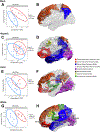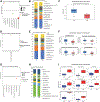How Discrimination Gets Under the Skin: Biological Determinants of Discrimination Associated With Dysregulation of the Brain-Gut Microbiome System and Psychological Symptoms
- PMID: 36754687
- PMCID: PMC10684253
- DOI: 10.1016/j.biopsych.2022.10.011
How Discrimination Gets Under the Skin: Biological Determinants of Discrimination Associated With Dysregulation of the Brain-Gut Microbiome System and Psychological Symptoms
Abstract
Background: Discrimination is associated with negative health outcomes as mediated in part by chronic stress, but a full understanding of the biological pathways is lacking. Here we investigate the effects of discrimination involved in dysregulating the brain-gut microbiome (BGM) system.
Methods: A total of 154 participants underwent brain magnetic resonance imaging to measure functional connectivity. Fecal samples were obtained for 16S ribosomal RNA profiling and fecal metabolites and serum for inflammatory markers, along with questionnaires. The Everyday Discrimination Scale was administered to measure chronic and routine experiences of unfair treatment. A sparse partial least squares-discriminant analysis was conducted to predict BGM alterations as a function of discrimination, controlling for sex, age, body mass index, and diet. Associations between discrimination-related BGM alterations and psychological variables were assessed using a tripartite analysis.
Results: Discrimination was associated with anxiety, depression, and visceral sensitivity. Discrimination was associated with alterations of brain networks related to emotion, cognition and self-perception, and structural and functional changes in the gut microbiome. BGM discrimination-related associations varied by race/ethnicity. Among Black and Hispanic individuals, discrimination led to brain network changes consistent with psychological coping and increased systemic inflammation. For White individuals, discrimination was related to anxiety but not inflammation, while for Asian individuals, the patterns suggest possible somatization and behavioral (e.g., dietary) responses to discrimination.
Conclusions: Discrimination is attributed to changes in the BGM system more skewed toward inflammation, threat response, emotional arousal, and psychological symptoms. By integrating diverse lines of research, our results demonstrate evidence that may explain how discrimination contributes to health inequalities.
Keywords: Brain resting state; Discrimination; Gut microbiome; Inflammation; Psychological symptoms; Systems biology.
Copyright © 2022 Society of Biological Psychiatry. Published by Elsevier Inc. All rights reserved.
Conflict of interest statement
All other authors report no biomedical financial interests or potential conflicts of interest.
Figures





Comment in
-
It's Not All in Your Head: Discrimination and Its Association With the Brain-Gut Axis.Biol Psychiatry. 2023 Aug 1;94(3):186-188. doi: 10.1016/j.biopsych.2023.05.004. Biol Psychiatry. 2023. PMID: 37437988 No abstract available.
References
-
- Causadias JM, Korous KM (2019): Racial discrimination in the United States: A national health crisis that demands a national health solution. J Adolesc Health 64:147–148. - PubMed
-
- Chiang JJ, Taylor SE, Bower JE (2015): Early adversity, neural development, and inflammation. Dev Psychobiol 57:887–907. - PubMed
-
- Nettis MA, Pariante CM, Mondelli V (2020): Early-life adversity, systemic inflammation and comorbid physical and psychiatric illnesses of adult life. Curr Top Behav Neurosci 44:207–225. - PubMed

